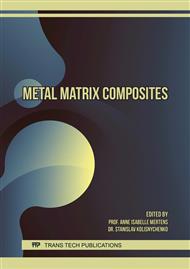p.1892
p.1898
p.1907
p.1914
p.1920
p.1927
p.1933
p.1939
p.1944
Foaming and Compressive Properties of A359/SiCP Metal Matrix Composites
Abstract:
In this work, a commercial MMC (A359-20% SiCP) was remelted, diluted to different particle contents (5 to 20 vol. %), and foamed at a fixed temperature using titanium hydride. In general, excellent foamability could be obtained for all SiC contents. Foam stability (retention of expansion), on the other hand, depended on SiC content. Remelting and diluting procedures also influenced the foam stability on account of varied oxide contents generated upon impeller stirring. The foam quality, in terms of cell wall integrity, improved with increasing SiC content. Despite the defect levels, good compression properties were obtained in these foams, which are close to model predictions. Overall, this system is very promising for producing good quality foams by melt processing technique.
Info:
Periodical:
Pages:
1920-1926
Citation:
Online since:
December 2018
Authors:
Keywords:
Price:
Сopyright:
© 2018 Trans Tech Publications Ltd. All Rights Reserved
Share:
Citation:



